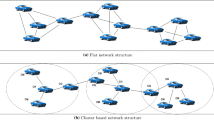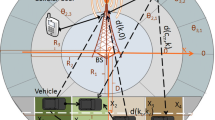Abstract
In this paper, we propose a scheme named “Adaptive Clustering and Scheduling for Dynamic Region-based Resource Allocation” (ACSR) to solve the problems in 3GPP’s fixed zone resource allocation schemes for 3GPP’s infrastructure-aided Vehicle-to-Vehicle (V2V) communication technology:Cellular V2V or C-V2V communications. In 3GPP’s fixed-zone resource allocation schemes, the radio channels are separated into groups each of which is reused amid pre-determined geographical zones with a fixed area and locations regardless of the number of vehicles sharing the group of channels assigned to a zone. On the other hand, in the proposed ACSR scheme, vehicles are dynamically and adaptively clustered by their geographical locations and banks of radio channels are reused amid clusters. This flexibility of vehicle clustering in which the number of vehicles in a cluster could fit the number of channels in a re-usable group of channels largely reduces the chance of co-channel interference and hence improve the transmission performance. A vehicle in a cluster is elected to be the cluster head for assigning radio channels to those which in its cluster are about to transmit so that both the overhead of signaling transmissions and computation complexity at eNB/gNB are reduced. The performance of ACSR are compared with several other typical resource allocation schemes by extensive simulations under the simulation scenario setting defined by 3GPP specifications. The performance metrics are (1) the average computation offloading ratio (COR) in reference to the centralized brute-force optimization scheme at eNB/gNB and (2) the average successful packet reception ratio (PRR) defined in 3GPP specification. The average COR for ACSR is 30.9%. The ACSR’s average PRR improvements over a typical fixed zone resource allocation scheme, the FZRA scheme, are greater than 5%, 10% and 21.8% when the transmission distance is 120 meters, 180 meters, and 320 meters, respectively. Simulation results shown that in general the ACSR scheme significantly improves the performance as compared to 3GPP’s fixed zone resource allocation schemes.



















Similar content being viewed by others
References
International Telecommunication Union, ITU Radiocommunication Sector Web Site, ITU-R, 2019. [Online]. Available: https://www.itu.int/en/ITU-R/ .
(2015). ITU Radiocommunication Sector, IMT Vision Framework and overall objectives of the future development of IMT for 2020 and beyond (M Series, Mobile, radiodetermination, amateur and related satellite services), ITU-R, Geneva, Switzerland, Recommendation ITU-R M.2083-0.
3rd Generation Partnership Project, 3GPP Web Site, 3rd Generation Partnership Project, 2019. [Online]. Available: https://www.3gpp.org/.
Molina-Masegosa, R., & Gozalvez, J. (2017). System level evaluation of LTE-v2v mode 4 communications and its distributed scheduling. In 2017 IEEE 85th Vehicular Technology Conference (VTC Spring), Sydney, NSW (pp. 1–5).
Fritzsche, R., & Festag, A. (2018). Location-Based Scheduling for cellular V2V systems in highway scenarios. In 2018 IEEE 87th Vehicular Technology Conference (VTC Spring), Porto (pp. 1–5).
Wei, C., Huang, A. C., Chen, C., & Chen, J. (2018). QoS-Aware Hybrid Scheduling for Geographical Zone-Based Resource Allocation in Cellular Vehicle-to-Vehicle Communications. IEEE Communications Letters, 22(3), 610–613.
(2016). 3rd Generation Partnership Project, Vehicle to Vehicle (V2V) Services Based on LTE Sidelink; User Equipment (UE) Radio Transmission and Reception, 3GPP, Tech. Report. TR 36.785.
(2016). 3rd Generation Partnership Project, Study on LTE-based V2X services, 3GPP, Tech. Report. TR 36.885.
(2015). 3rd Generation Partnership Project, Study on LTE support for Vehicle-to-Everything (V2X) services, 3GPP, Tech. Report. TR 22.885.
Arthur, D., & Vassilvitskii, S. (2007). K-means++: the advantages of careful seeding. In Proceedings of Symposium in Discrete Algorithms (pp. 1027–1035).
(2019). 3rd Generation Partnership Project, Evolved Universal Terrestrial Radio Access (E-UTRA); Multiplexing and channel coding, 3GPP, Tech. Specification. TS 36.212.
Lloyd, S. (1982). Least squares quantization in PCM. IEEE Transactions on Information Theory, 28(2), 129– 137.
Drineas, P., Frieze, A., Kannan, R., Vempala, S., & Vinay, V. (2004). Clustering large graphs via the singular value decomposition. Machine Learning, 56(1-3), 9–33.
(2010). CELTIC CP5-026 WINNER+ Project, Final channel models, CELTIC, Deliverable D5.3.
(2015). NTT DOCOMO, Discussion on Resource Allocation Enhancement for PC5 based V2V communications, 3GPP, TSG RAN WG1#83, Tech. Document. R1-157438.
(2015). LG Electronics, Discussion on Enhancement for PC5 Based V2V Resource Allocation 3GPP, TSG RAN WG1#83, Tech. Document. R1-157435.
Acknowledgments
This work was supported in part by MOST Taiwan under contracts 108-2221-E-259-005- and 109-2634-F-259-001-.
Author information
Authors and Affiliations
Corresponding author
Additional information
Publisher’s Note
Springer Nature remains neutral with regard to jurisdictional claims in published maps and institutional affiliations.
Rights and permissions
About this article
Cite this article
Chen, CY., Chen, JY., Lin, PR. et al. Adaptive Clustering and Scheduling for Dynamic Region-based Resource Allocation in V2V Communications. J Sign Process Syst 92, 1349–1368 (2020). https://doi.org/10.1007/s11265-020-01535-0
Received:
Revised:
Accepted:
Published:
Issue Date:
DOI: https://doi.org/10.1007/s11265-020-01535-0




